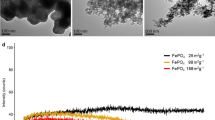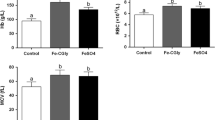Abstract
Background
The study of iron metabolism is essential in nutritional sciences as iron deficiency is one of the most common nutritional deficiencies in humans and represents a serious health problem worldwide. The mouse is utilized as a unique and powerful model for the identification and characterization of genes involved in iron metabolism and for studying the pathogenesis of iron disorders. Thus, sophisticated and sensitive techniques have been developed to study iron metabolism in this animal model. In particular, iron absorption has been studied in mice by using the radioisotopes 55Fe and 59Fe in tied-off or dissected and everted duodenal segments. Nevertheless, several drawbacks discourage the extended use of these approaches.
Methods and results
Here, we report the use of the stable isotope 57Fe to measure iron absorption in mice. We show that after oral administration of 57Fe-containing solutions, it is possible to measure both duodenal iron retention and duodenal iron transfer to specific organs, using inductively coupled plasma mass spectrometry (ICP-MS). As 57Fe is administered orally, no surgical operation is needed before the end of the experiment, thus allowing the measurement of iron absorption under physiologic conditions. Moreover, the use of ICP-MS for 57Fe detection ensures high sensitivity and provides quantitative data. Finally, the use of a stable isotope enables the measurement of both iron absorption and histologic and/or biochemical analyses in the same animal.
Conclusions
The use of 57Fe to measure iron absorption in mice, therefore, represents an alternative to radioisotope-based methods, providing a new tool to extend our knowledge on the mechanism of iron absorption.



Similar content being viewed by others
References
Hentze MW, Muckenthaler MU, Galy B, Camaschella C (2010) Two to tango: regulation of mammalian iron metabolism. Cell 142:24–38
Andrews NC (2008) Forging a field: the golden age of iron biology. Blood 112:219–230
Bernstein SE (1987) Hereditary hypotransferrinemia with hemosiderosis, a murine disorder resembling human atransferrinemia. J Lab Clin Med 110:690–705
Edwards JA, Hoke JE (1972) Defect of intestinal mucosal iron uptake in mice with hereditary microcytic anemia. Proc Soc Exp Biol Med 141:81–84
Fleming MD, Trenor CC 3rd, Su MA, Foernzler D, Beier DR et al (1997) Microcytic anaemia mice have a mutation in Nramp2, a candidate iron transporter gene. Nat Genet 16:383–386
Trenor CC 3rd, Campagna DR, Sellers VM, Andrews NC, Fleming MD (2000) The molecular defect in hypotransferrinemic mice. Blood 96:1113–1118
Nicolas G, Bennoun M, Devaux I, Beaumont C, Grandchamp B et al (2001) Lack of hepcidin gene expression and severe tissue iron overload in upstream stimulatory factor 2 (USF2) knockout mice. Proc Natl Acad Sci USA 98:8780–8785
Wang RH, Li C, Xu X, Zheng Y, Xiao C et al (2005) A role of SMAD4 in iron metabolism through the positive regulation of hepcidin expression. Cell Metab 2:399–409
Meynard D, Kautz L, Darnaud V, Canonne-Hergaux F, Coppin H et al (2009) Lack of the bone morphogenetic protein BMP6 induces massive iron overload. Nat Genet 41:478–481
Camaschella C (2005) Understanding iron homeostasis through genetic analysis of hemochromatosis and related disorders. Blood 106:3710–3717
Iolascon A, De Falco L, Beaumont C (2009) Molecular basis of inherited microcytic anemia due to defects in iron acquisition or heme synthesis. Haematologica 94:395–408
Laftah AH, Raja KB, Beaumont N, Simpson RJ, Deacon A et al (2004) The effects of inhibition of haem biosynthesis by griseofulvin on intestinal iron absorption. Basic Clin Pharmacol Toxicol 94:161–168
Masaratana P, Laftah AH, Latunde-Dada GO, Vaulont S, Simpson RJ et al (2011) Iron absorption in hepcidin1 knockout mice. Br J Nutr 105:1583–1591
Walczyk T, von Blanckenburg F (2002) Natural iron isotope variations in human blood. Science 295:2065–2066
Krayenbuehl PA, Walczyk T, Schoenberg R, von Blanckenburg F, Schulthess G (2005) Hereditary hemochromatosis is reflected in the iron isotope composition of blood. Blood 105:3812–3816
Chen Z, Griffin IJ, Plumlee LM, Abrams SA (2005) High resolution inductively coupled plasma mass spectrometry allows rapid assessment of iron absorption in infants and children. J Nutr 135:1790–1795
van den Heuvel EGHM, van Dokkum W, Schaafsma G (1997) Methods to measure iron absorption in humans: a review. Food Rev Int 13(1):91–102
Young MF, Glahn RP, Ariza-Nieto M, Inglis J, Olbina G et al (2009) Serum hepcidin is significantly associated with iron absorption from food and supplemental sources in healthy young women. Am J Clin Nutr 89:533–538
Zhou XY, Tomatsu S, Fleming RE, Parkkila S, Waheed A et al (1998) HFE gene knockout produces mouse model of hereditary hemochromatosis. Proc Natl Acad Sci USA 95:2492–2497
Pieroni L, Khalil L, Charlotte F, Poynard T, Piton A et al (2001) Comparison of bathophenanthroline sulfonate and ferene as chromogens in colorimetric measurement of low hepatic iron concentration. Clin Chem 47:2059–2061
Dupic F, Fruchon S, Bensaid M, Loreal O, Brissot P et al (2002) Duodenal mRNA expression of iron related genes in response to iron loading and iron deficiency in four strains of mice. Gut 51:648–653
Hentze MW, Muckenthaler MU, Andrews NC (2004) Balancing acts: molecular control of mammalian iron metabolism. Cell 117:285–297
Wienk KJ, Marx JJ, Beynen AC (1999) The concept of iron bioavailability and its assessment. Eur J Nutr 38:51–75
Frazer DM, Wilkins SJ, Becker EM, Murphy TL, Vulpe CD et al (2003) A rapid decrease in the expression of DMT1 and Dcytb but not Ireg1 or hephaestin explains the mucosal block phenomenon of iron absorption. Gut 52:340–346
Laftah AH, Latunde-Dada GO, Fakih S, Hider RC, Simpson RJ et al (2009) Haem and folate transport by proton-coupled folate transporter/haem carrier protein 1 (SLC46A1). Br J Nutr 101:1150–1156
Owen GM, Kirkman S, Williams M, Jacobs A (1967) A simple method for measuring iron absorption using a scintiscanner for whole-body counting. Br J Radiol 40:866–868
Acknowledgments
We thank Antonello Pietrangelo for Hfe-null mice and Radhika Srinivasan for editing of the manuscript. This work was supported by the Italian Ministry of University and Research to E.T. and F.A., and by the Regione Piemonte to F.A.
Conflict of interest
The authors declare no conflicts of interest.
Author information
Authors and Affiliations
Corresponding author
Additional information
Veronica Fiorito, Simonetta Geninatti Crich, Silvio Aime and Emanuela Tolosano are equally contributed.
Rights and permissions
About this article
Cite this article
Fiorito, V., Geninatti Crich, S., Silengo, L. et al. Assessment of iron absorption in mice by ICP-MS measurements of 57Fe levels. Eur J Nutr 51, 783–789 (2012). https://doi.org/10.1007/s00394-011-0256-6
Received:
Accepted:
Published:
Issue Date:
DOI: https://doi.org/10.1007/s00394-011-0256-6




